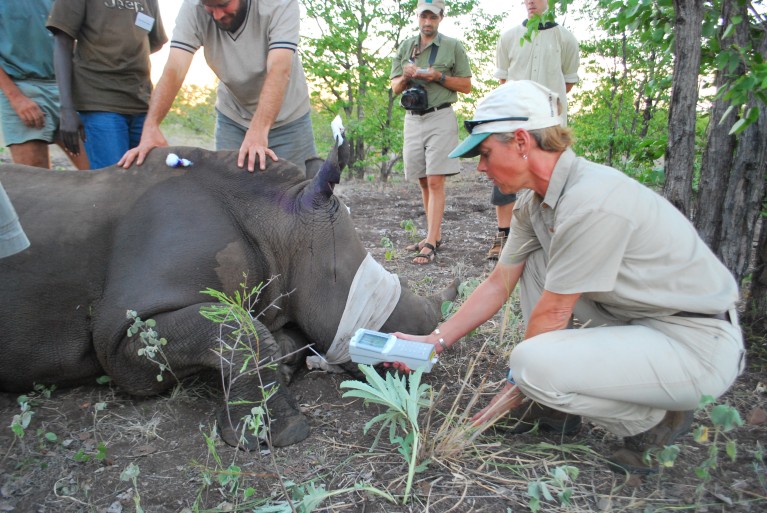
Michele Miller, professor at the Animal Tuberculosis Research Group, Stellenbosch University, South Africa, testing a rhinoceros in the Kruger National Park.Credit: Michele Miller, Stellenbosch University.
The largest study ever conducted on a free-ranging population of rhinoceros, showed that about one in every seven rhinos in the Kruger National Park, South Africa, had been infected with Mycobacterium bovis, the pathogen that causes bovine tuberculosis (bTB).
Survival of the African rhinoceros is threatened by poaching, habitat loss, and climate effects. The presence of Mycobacterium bovis in wild populations creates an additional potential threat to health and conservation programs, the authors write in the PNAS study.
Michele Miller, co-author of the study, is a professor, wildlife veterinarian and immunologist with a strong interest in infectious disease, especially tuberculosis in animals. She leads the Animal TB Research Group at the University of Stellenbosch, South Africa, and lives and works in the Kruger National Park.
“TB is a threat to conservation efforts since rhinoceros in infected populations are not permitted to be moved to safer locations without testing, to ensure that they do not spread disease. Our research has led to developing tests that have been approved for screening,” she says.
Quarantine is currently imposed on rhino populations at the park. Specialized bomas (holding pens) have been built to hold rhinos for testing which occurs over a period of three months. If the animals have negative test results they can be safely moved to other locations. However, it is very costly to feed, house, and test rhinos.
Managing TB in a population is extremely expensive and requires years of repeated testing, removal of infected animals, and quarantine of the premises. These barriers mean that in some cases testing is not carried out, leading to unnecessary culling.
Improved tests are in demand since there are currently limited diagnostic options for TB in wildlife, including African buffaloes, warthogs, African elephants, African lions, cheetahs, leopards, wild dogs, hippos, baboons, and meerkats.
Although TB can lead to disease and death in rhinoceros, especially in captivity, it does not appear to be affecting populations levels at this time. Usually otherwise healthy animals can often control or even eliminate the infection, like humans.
“However, when a rhinoceros is stressed by drought, other diseases and age, it can suppress the immune system. The first cases of TB in both black and white rhinoceros in Kruger National Park were discovered well into the most recent period of drought. It is likely that these animals developed disease due to the long-term consequences of poor nutrition,” Miller explains.
“Since we are dealing with free-ranging wild rhinoceros in a very large area, it is difficult to know how infection affects their behavior, susceptibility to other diseases, and overall health. From cases in zoo rhinos, we know that these animals can be infected for years, sometimes decades, before they develop clinical signs (such as weight loss, respiratory signs) when the disease is well advanced.
Miller and her team believes there is cross-species infection, based on looking at the genetic makeup of bacteria found in the different animals. For predators, the most likely source of infection is eating an infected animal, such as a buffalo, warthog, or kudu.
“In the case of herbivores, close prolonged contact such as in buffaloes can result in spread through aerosol droplets, similar to humans. Our recent paper suggests that rhinoceros may become infected indirectly through environments contaminated by buffaloes. So infected buffaloes will release bacteria from respiratory secretions on to vegetation, which rhinos consume or inhale,” Miller says.
